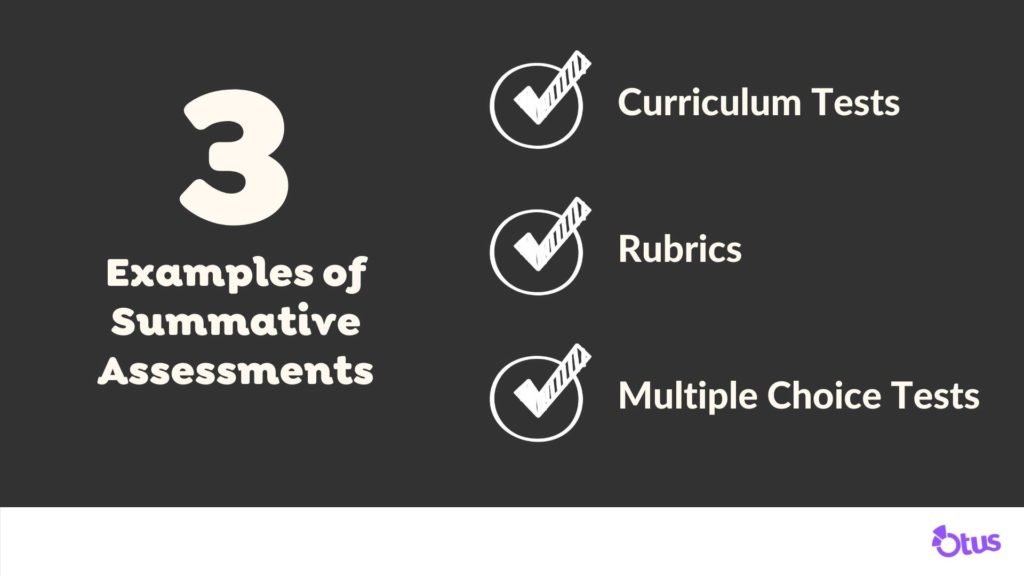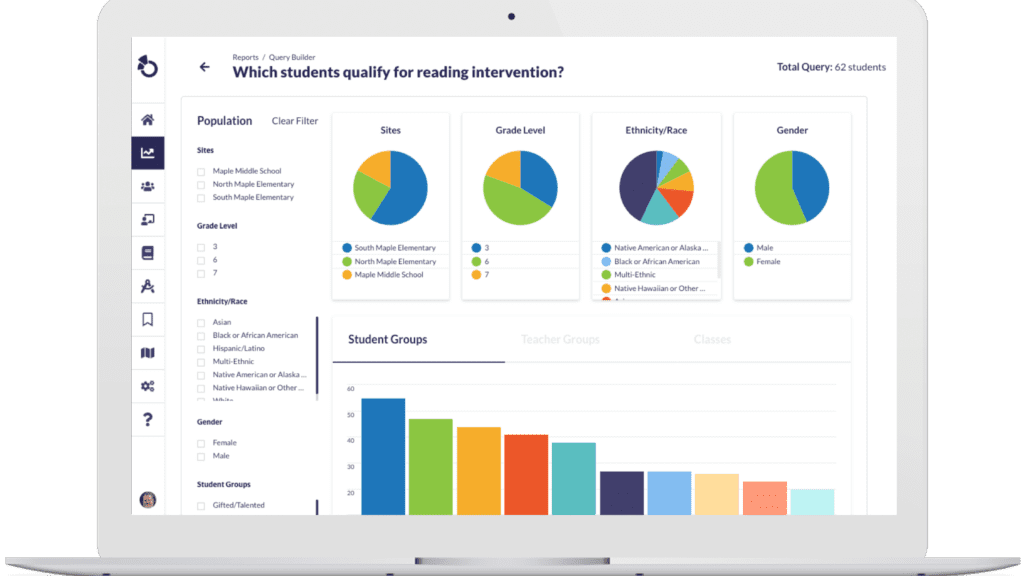The Ultimate Guide to Summative Assessments
What are summative assessments in education?
Summative Assessments are—in simple words—the way educators determine what a student has learned. They are typically tests or cumulative assignments that provide teachers with insights into the overall success of their instructional methods. Summative assessments also reveal if students have or have not mastered the learning targets or standards. Additionally, summative assessments provide school administrators, districts, and other key decision makers with actionable data and insight into how successfully a curriculum or teacher performs.

Summative assessments must be created following specific guidelines, which are outlined in detail below. In brief, summative assessments must provide valid, reliable data points that can be compared across classrooms, across time, and across graders in order to measure student growth and teacher, district, or curriculum efficacy.
What does a summative assessment measure?
Summative assessments measure student learning along with teacher and curriculum effectiveness. Unlike formative assessments, which are often low-stake check-ins, summative assessments are typically high stakes, serving not only as the cumulation of a unit, semester, or school year, but also frequently serving as the key factor in a student’s grade or an administrator’s decision about a teacher or curriculum.
Teachers who incorporate mastery learning into their instructional process rely heavily on summative assessments to measure whether or not a student has mastered the content taught. When they have finished their units, teachers offer a summative—or cumulative—test, project, or essay to determine if students have reached the key learning targets. If a student does not reach a predetermined score (80%, according to most mastery learning models), teachers adjust what content comes next and often provide strategic interventions to provide students with the time needed to truly master the content. In this way, summative assessments can be thought of as formative, in that teachers inform next steps based on summative results.
Why are summative assessments used in education?
Summative assessments are highly valued in education due to the valuable data they provide. Unlike formative assessments, which are typically more subjective and rarely designed to be used across classrooms or schools for comparative purposes, summative assessments are created for validity and reliability.
Validity in summative assessments—or the ability of an assessment to actually measure what it is supposed to measure—ensures that teachers can be confident that students have or have not mastered the key learning objective. Additionally, valid summative assessments mean that educators and administrators are able to trust the summative assessment’s data about whether or not a teacher or curriculum performed as expected. A summative assessment’s validity ensures that decisions are made according to the true learning targets and not some side topic that may have unintentionally found its way into the assessment.
Reliability in summative assessments—or the ability of an assessment to reproduce consistent outcomes across time and setting regardless of grader—ensures that teachers and administrators are making decisions using accurate data, not outlying data. This is especially important in situations where a teacher’s salary or a controversial curriculum hangs in the balance.
Many educators have found that online tools allow them to more effectively gather and analyze data for validity and reliability, and to measure trends over time. Additionally, online tools allow teachers to quickly spot anomalies so they know which students need enrichment or intervention.
How do you write a summative assessment?
Summative assessments must be written according to a few specific guidelines.

First, in order to ensure a summative assessment is valid, teachers must:
- Determine the key learning objectives or standards that they will teach.
- Decide on what format will best showcase whether or not that objective or standard has been met. In some cases, a multiple choice test might work best; in others, teachers may need to choose something more along the lines of an essay or project.
- Ensure that students understand the learning objectives, the method of the summative assessment, and the grading scale or rubric. Students are far more likely to not only perform better on summative assessments but also to engage and take ownership in their learning when they clearly understand what they are being asked to do and why.
- Plan and teach curriculum that closely aligns with the learning objectives and parallels the summative assessment.
Second, in order to ensure a summative assessment is reliable, teachers must:
- Create a comprehensive grading plan—or rubric—to ensure data is consistently and correctly gathered.
- Ensure classroom instruction and curriculum follows the same plan across classrooms or year over year, depending on how the teacher is planning to use the data from the summative assessments.
- Decide on how the summative assessment will be given in order to ensure consistent results across classrooms or time. Does it always need to be given at a specific time of day or of year? Does the classroom need to be set up a certain way? Does the teacher provide specific prompts or help during the assessment?
- Create and execute the summative assessment according to the predetermined guidelines. Many teachers find it helpful to bring their summative assessments to their Professional Learning Communities (PLCs) for help in spotting questions that could take away from the test’s validity or reliability.
- Grade the summative assessment according to the predetermined guidelines. Many teachers find it helpful to bring in “blind graders”—fellow staff or other experts to grade the assessments without any background knowledge of students or classroom instruction.
Third, teachers should take time to analyze the results of their summative assessment. Did students master the learning targets or standards? Did this unit drive their understanding and comprehension forward? Or will they need intervention and help before moving on to the next unit or goal? Teachers should then make decisions about how to proceed.
Fourth, teachers should report findings to the stakeholders—students, parents, administrators, and the like. Students are far more likely to improve their learning when they receive descriptive feedback—clear, exact descriptions of what a student got right or wrong, and more importantly, why they made certain mistakes and how to correct them.
Finally, many teachers find it valuable to bring the results of their summative assessments back to their PLCs. While there, teachers find support in analyzing data, understanding results, and creating intervention plans.

How do summative assessments fit in with the 5 types of assessment?
There are five foundational types of assessments:
- Diagnostic assessments, or pre-assessment, which teachers use to gauge students’ pre-knowledge and zone of proximal development. These typically occur once at the beginning of a unit.
- Formative assessments, which teachers use to determine where student knowledge is at mid-unit. These typically occur frequently throughout the unit.
- Summative assessments, which teachers use to determine student growth at the end of a unit. These typically occur once at the end of a unit.
- Interim assessments, which districts use to measure specific grades across schools. These typically occur once a year.
- Benchmark assessments, which bigger bodies (e.g. states) use to measure overarching student growth and school effectiveness. These typically occur once a year.
Typically, teachers create their diagnostic assessments to mirror their summative assessments in order to easily compare the results of a summative assessment to its unit’s diagnostic assessment. This allows teachers to quickly and easily see if students grew in the desired knowledge during the unit.

Additionally, many teachers work to align the majority of their formative assessments with their summative assessments. For example, teachers may use questions similar to the questions found on the summative assessments as exit tickets throughout the unit. They do this to tap into the “testing effect” of formative assessments: by allowing students to “test” themselves in a low-stakes environment, they are enabling students to recall up to 67% more of what they’ve learned on the final summative assessment than students would have via other study methods.
While summative assessments are not always interim and benchmark assessments, these two categories would fall under the same umbrella as summative assessments, as both teachers and administrators use interim and benchmark assessments to not only determine what students have learned, but to make decisions about staffing, curriculum, or school success.
What are examples of summative assessments?
While there is no one right summative assessment, it is important that teachers use or create summative assessments that will provide valid, reliable data across classrooms or year over year. For example, many teachers use:

- Curriculum Tests: Although a teacher may tweak the test created by the curriculum here or there to align with their state or district’s learning targets, using the curriculum test provides a large degree of validity and reliability, and teachers can easily use the same test (with the same tweaks) in every class for as long as they use that curriculum.
- Rubrics: It is essential that teachers create strong, detailed rubrics when they choose to use writing assignments or final projects. Although it may take the teacher a few rounds with their Professional Learning Communities (PLCs) and iterations in classrooms, eventually teachers should land on a rubric that they can use year over year for reliable data.
- Multiple Choice Tests: These are perhaps the easiest summative assessments to use in terms of gathering and comparing data. However, it can be easy to create multiple-choice questions that don’t align well with the learning objectives, which compromises the validity of the test. Teachers do well to bring their multiple-choice tests to PLCs to get peer feedback on their summative assessments before bringing them to their class.
Again, it’s important to note that regardless of what type of assessments teachers choose to use, these assessments should be used to gauge student learning and make critical decisions about how to enhance the learning process so students receive the best learning opportunities possible.
Related Resources
Request a demo!
See exactly how Otus can help your school accelerate student growth and improve student outcomes – all while saving educators time.




